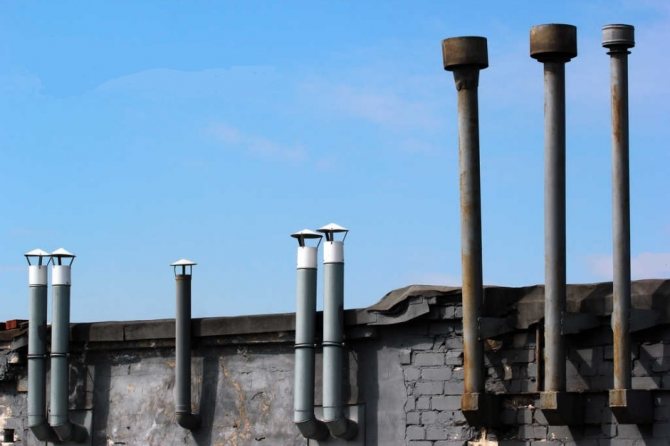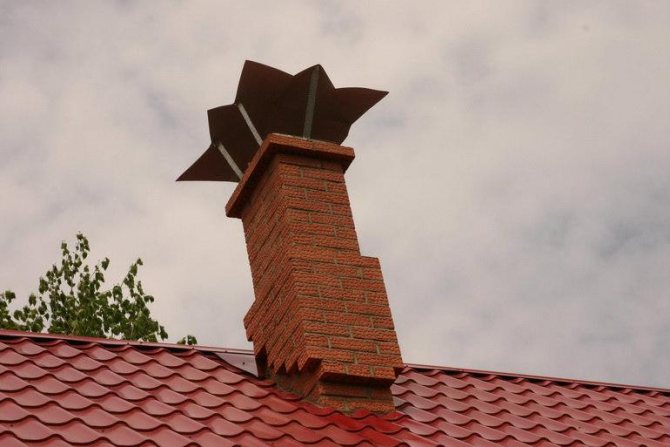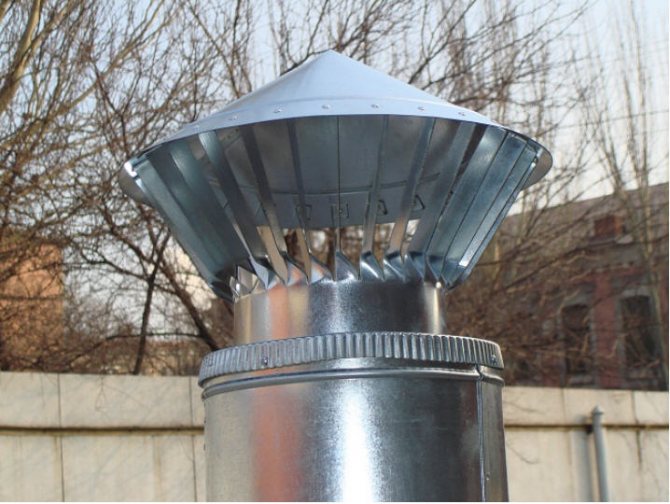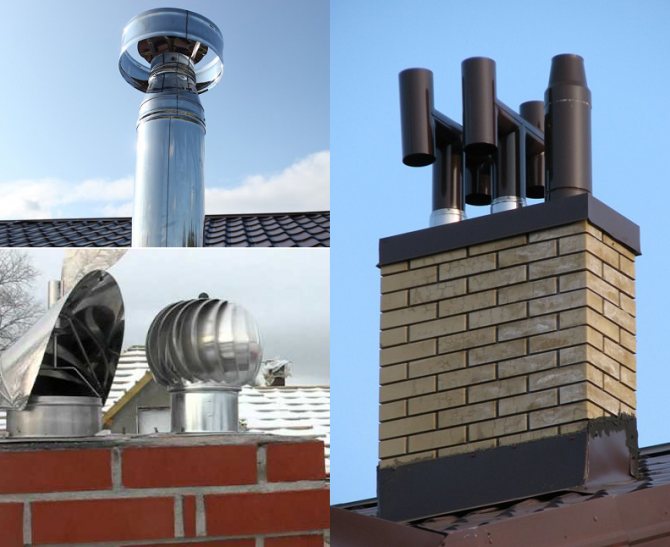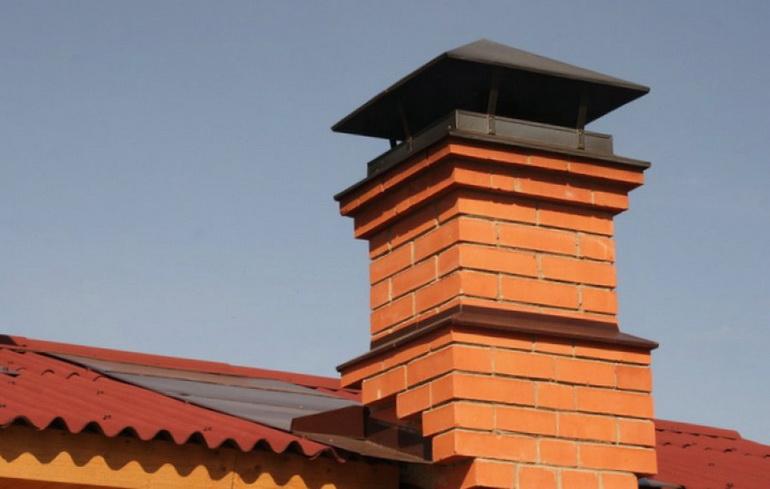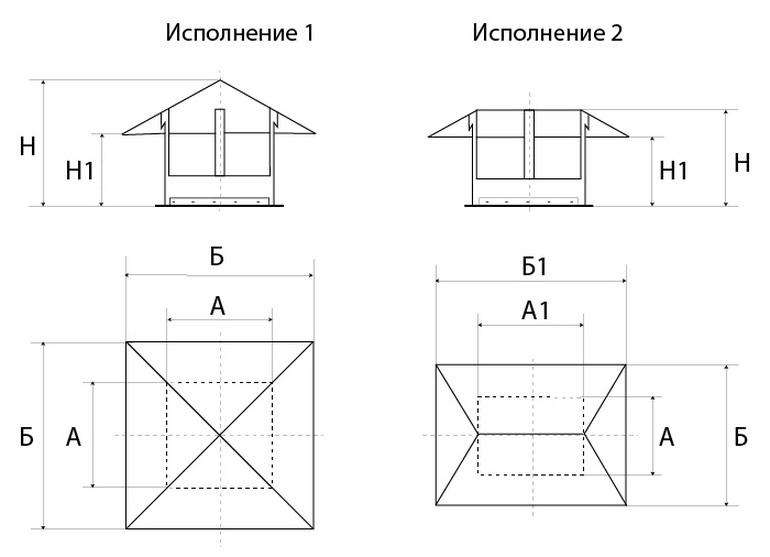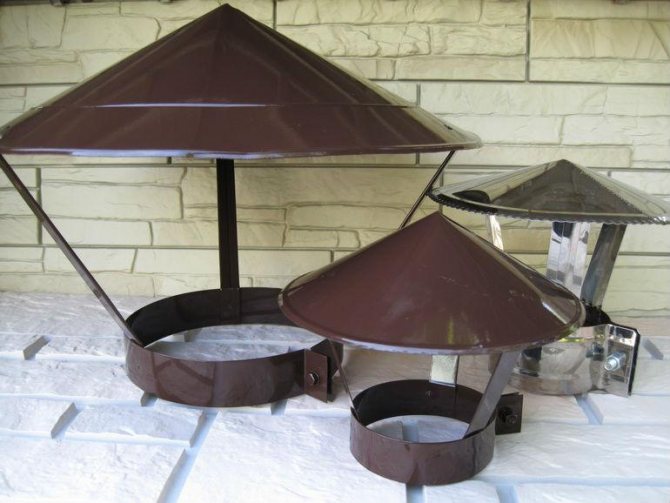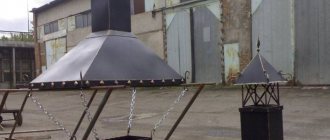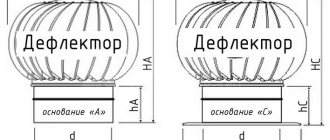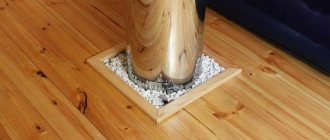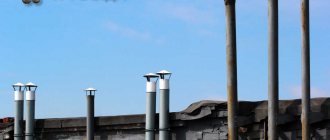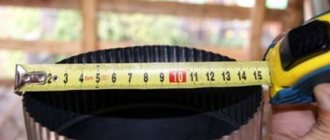Complementary elements for the roof are represented, in most cases, by metal or modern plastic products.
Such elements are used in the areas of roof joints, and also close the joints and ends, which gives the structure additional strength and protects it from the effects of destructive moisture.
The category of additional elements also includes smoke umbrellas, which are an integral part of both steel chimneys and classic brick chimney systems.
Chimney umbrella - what is it and why is it needed
A protective umbrella is the top of a cap, which in appearance can be a cone, pyramid, semicircle, or other more complex designs and shapes.
The functions of the umbrella that is installed on the chimney are as follows:
- the ingress of atmospheric water or snow into the chimney is prevented... A side effect of heavy rainfall is the accumulation of a large amount of moisture in the chimney, causing a decrease in natural air draft;
- arrangement of a brick chimney with an umbrella prevents material destruction, and the presence of special grooves allows all accumulating condensate to be discharged in a timely manner;
- the presence of a chimney umbrella does not allow insects to enter the chimney, animals and birds, leaves and other objects carried by gusts of wind.

Chimney umbrellas
IMPORTANT!
You also need to remember that when using an umbrella, traction is noticeably improved, and the standard indicators for increasing this level of this parameter are about a third of the total volume.
The umbrella does not prevent the exhaust of smoke with combustion products only with the right choice of such a device... For example, in areas with heavy snowfall, it is advisable to use additional elements with a large angle of inclination for the unhindered melting of the snow mass.
What tasks does a protective umbrella perform?
Installing an umbrella on the chimney helps to maintain the heating system in optimal mode, prevent premature aging of the chimney, and improve air circulation in the house.
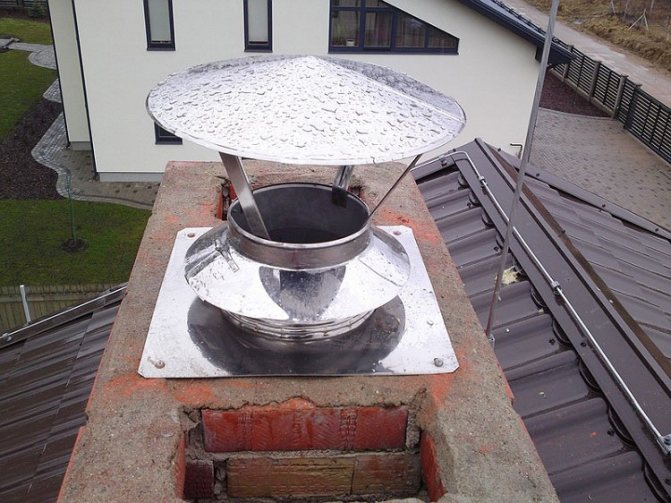

Pipe caps and caps are designed for the following purposes:
- close the ventilation duct, protecting it from rain, snow and dirt. Lack of protection can lead to the accumulation of a large amount of water in the chimney, which contributes to a decrease in draft and, accordingly, a drop in the efficiency of the heating system;
- protect the pipe material from damage by draining the accumulated condensate due to the presence of special grooves;
- do not allow insects and birds to fall into the pipe, serve as an obstacle to leaves and branches from trees;
- perform a decorative function. They give the roof a complete look, especially if there are elements of artistic forging in the structure.
Note! With the help of an umbrella, you can solve one of the problems of dampness in the house or bath. If the chimney is exposed to all winds and rains, moisture that has got into it penetrates into the premises. As a result, the walls and floors are affected by fungus, an unpleasant odor appears in the air.
Some types of hoods are designed to create a rarefied environment in the upper part of the pipe. Due to this, an improvement in the draft in the chimney is achieved, excess moisture, exhaust air and combustion products are removed faster.
We recommend that you familiarize yourself with: Stripping for propylene reinforced pipes
What is the difference between an umbrella and a weather vane, a cap, a head and a chimney
A chimney, a weather vane, a cap, an umbrella and a head - rather simple and time-tested protective structures for air outlets on the roof... Steel, copper, aluminum, plastic and titanium-zinc additional elements, if properly arranged, have been in operation for ten, and sometimes more, years, providing comfortable and safe living:
- caps - the general name for elements that prevent atmospheric precipitation and foreign objects from entering the chimney, as well as carrying a decorative load;
- chimneys - rectangular or square decorative caps designed for arranging chimney and ventilation pipes;
- umbrellas - presented by caps, characterized by a simple design and intended for round or square pipes;
- deflectors - caps for round pipes, characterized by a rather complex internal structure to increase traction.
Wind vane also belongs to the category of complex structures. - rotating hoods directing the outgoing smoke exclusively in one direction, depending on the direction of the wind.
NOTE!
Umbrellas are used to equip a round or square head, but modern manufacturers, in addition to functionality, take into account ease of use, including the addition of a cover with a smoke divider.
What is the difference between a chimney umbrella and other protective devices
A protective role for chimneys is performed along with umbrellas, chimneys, wind vane deflectors, and a head.
Umbrellas and chimneys practically do not differ from each other structurally. Both devices perform a decorative function, well protect ventilation ducts from clogging and rainwater. Umbrellas are installed on pipes of round and square cross-section, and chimneys - mainly on pipes of rectangular cross-section.
A deflector designed for round pipes has a more complex design. The annular deflector casing has a special aerodynamic property: the wind bends around it and creates a rarefied atmosphere, which leads to improved thrust.
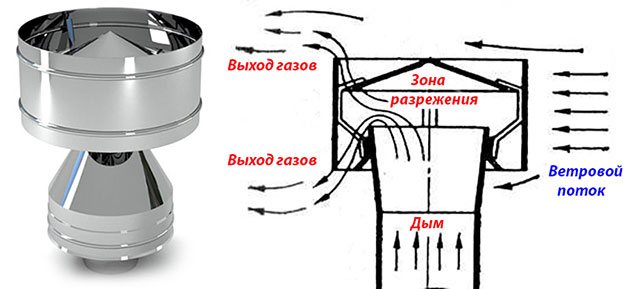

The most difficult to manufacture is a weather vane. The product is a cap rotating on a bearing, capable of directing smoke in the direction the wind blows. In this case, the effect of increasing thrust is observed.
The nozzle-shaped cylindrical head differs from the umbrella in that it has a hole in the upper part. Designed for chimneys in systems with gas and diesel heat generators.
Types of protection for the chimney and ventilation pipe
The classification of types of umbrellas is due to the shape, purpose, as well as the materials used in the manufacture.
Depending on the shape, the most common are standard designs that repeat the appearance of a hipped roof, as well as varieties in the form of a mushroom head.
Varieties can be represented by droppers and drainage systems, designed to collect and further drain all flowing moisture, as well as prevent it from getting inside.
Various non-ferrous or ferrous metals can be used to make a fungus or an umbrella, but galvanized durable steel is most often used.
Deflectors also belong to the varieties of the smoke umbrella, which serve as a very effective spark extinguisher.
The appearance of the structure and materials for the manufacture of the chimney "fungus" do not have a significant effect on the performance indicators, therefore, when choosing, consumers should focus on finances and personal preferences in decor.
An umbrella for a chimney: which one to choose or how to make it yourself?
Good day, dear reader! Each of us has come across chimney and ventilation systems. Sometimes it happens that the ventilation system does not cope with the function assigned to it, the draft is insufficient, which significantly complicates the ventilation of the room. An important element of the ventilation structure is the hood for the chimney.In this article, we will tell you what it is intended for, what types there are and how to properly install this product.
What is a chimney umbrella and why is it needed
A pipe umbrella is a device that is located at the top of a house pipe and carries several functions. In appearance, the following main types are distinguished: in the form of a cone, pyramid and semicircle, there are also umbrellas of more complex designs. It is installed both on the chimney and on the ventilation pipe.
It has several main functions:
- Prevents precipitation from entering the chimney or ventilation system. When moisture accumulates inside the chimney, the functions of the draft of the air system are reduced by an order of magnitude.
- Prevents destruction of the chimney. It significantly increases the service life of the pipe, and with proper arrangement, it is possible to drain the accumulated condensate through special grooves.
- Debris protection. Protects from the entry of leaves, insects and other foreign objects into the system.
- Increase in traction properties. Increases traction by almost a third.
Despite the ease of installation and low cost, the umbrella has many advantages. When choosing an umbrella, you should also pay attention to the fact that your friends and neighbors will see it, so if possible, do not forget about the design.
What is the difference between an umbrella and a weather vane, a cap, a head and a chimney
There are several types of products that are installed on the pipe. They differ in their structure and principle of operation. The main ones can be distinguished: an umbrella, a weather vane, a cap, a head and a chimney. We have already sorted out what an umbrella is, now let's define the rest of the concepts.
A weather vane is often a decorative element, in the form of a bird or a dragon. The weather vane is designed in such a way that it has a rotating element, that is, it rotates from the wind flows. Its main purpose is to strengthen the air outlet from the chimney, that is, to increase the draft.
A chimney - in common people, this is any device that decorates a chimney.
A cap is a device that is usually used to decorate and protect the neck of the pipe, that is, it is a kind of continuation of the chimney. Attached to the outside of the pipe with brackets.
Head - this device is the most complex in its design. Because the head is not just the top of the chimney, it is a complex of absolutely all elements designed to protect the chimney. The headrest is quite difficult to make on your own, but you can find a large selection of designs in a specialized store.
As you and I see each device has its own purpose and function. Additionally, it differs from each other in appearance and cost.
Types of ventilation hoods
The pipe umbrella is designed for chimney and ventilation systems. There are several varieties of the cap, depending on its shape, let's look at the main ones.
Round
A round umbrella is installed on the head of the ventilation pipe. Due to their shape, they have good protection against precipitation, and they are additionally equipped with a mesh to prevent foreign objects from entering the ventilation system. Such umbrellas are produced mainly from steel and copper.
Rectangular
Unlike round, it has a square or rectangular shape. Such an umbrella is installed most often on an insulated exhaust shaft and fastened with a nipple connection. The inlet can also be protected with a mesh.
Sewer
This type of umbrella is installed on sewer pipes, and in addition to the main functions, it additionally regulates the pressure in the pipe. The material for the manufacture is PVC, due to which it can withstand up to plus 60 degrees Celsius.
When fastening, a socket joint is used, additionally sealed with a rubber ring, in order to avoid leakage.
Ventilation
The ventilation hood is installed indoors above the stove or gas cabinet. Its purpose is indoor air purification. For efficiency, such an umbrella is additionally equipped with a fan and a filter, which helps to better purify the air and eliminate unnecessary odors.
There are two main types of hoods:
- Wall-mounted - installed and mounted on the wall above the source of steam and moisture. Large-sized types are additionally fixed to the ceiling.
- Central - installed in rooms where there are several sources requiring ventilation, often restaurants and catering kitchens.
Deflector / cap
This is a special kind of umbrella that is installed on the top of the chimney. Its main purpose is to increase the thrust in the system. The deflector has high aerodynamic properties and operates according to Bernoulli's law. The presence of such an umbrella on the ventilation system will significantly increase the traction efficiency.
How to choose
When choosing an exhaust hood, you need to take into account the functions for which it will be intended.
When choosing a ventilation umbrella, you should pay attention to the following characteristics:
- Dimensions. To select a size, proceed from the fact that the width is 10 centimeters larger than the surface for which it will be installed.
- Indoor temperature. When choosing, it is worth considering the temperature of the vapors and gases entering the chimney. On this point, it is better to use the advice of a specialist.
- Air flow. This indicator is calculated from the indicators of the volume of the room, the power and the number of installed plates. Prepare this data before buying and announce it to a specialist.
- Air speed and drag. The air exchange of the umbrella should be between 0.8 and 1.5 meters per second. If the speed indicator is lower, it will significantly reduce the quality of work.
When choosing, pay attention first of all to the type of umbrella that you require (see above), and already when buying and manufacturing, proceed from this parameter.
How to mount
When installing a pipe umbrella, you will need to use fasteners, they will need to be selected based on the selected umbrella design and the thickness of the chimney. Also, when choosing a chimney, do not forget about the diameter of the pipe, they must be identical.
The work will be carried out on the roof of the house, so if you do not have a good ladder and a long carrier for your drill, use the services of a specialist.
How to do it yourself
Making a pipe exhaust hood is a simple and straightforward process. Before starting work, it is worth choosing a scheme and taking off the dimensions of the pipe itself.
Schemes and sizes
On the Internet, you can find a huge selection of schemes for installing a roof ventilation hood. Before starting work, be sure to read the size table used in the diagrams.
Before starting work, we recommend making a model out of paper and checking the correct size.
We bring to your attention one of the simplest umbrellas, which consists of a cylindrical base, a cone-shaped roof and three holding legs.
Material preparation
Preparation is an essential element of any job. For manufacturing you will need:
- galvanized steel sheet;
- a sheet of cardboard;
- pencil;
- ruler;
- compass;
- scissors for metal;
- bolts with nuts or rivets.
Choice of design
We offer two of the simplest designs, and we show them in the figure (Fig. 1). The difference between these schemes is in the form of a roof that will be manufactured. Depending on the selected pattern, use the following dimensions:
Execution 1.
| BUT | B | H | H1 |
| 25 | 45 | 24 | 15 |
| 50 | 90 | 40 | 25 |
| 100 | 180 | 81,1 | 53,8 |
Execution 2.
| BUT | B | B1 | B2 | H | H1 |
| 25 | 45 | 40 | 72 | 40 | 25 |
| 50 | 90 | 80 | 144 | 93 | 63,8 |
| 80 | 144 | 100 | 180 | 99,5 | 63,8 |
You select the size based on your pipe, we give you the main dimensions, if you could not find a suitable one, use another scheme (you can easily find it on the Internet).
Procedure
Carry out the work in the following order:
- Draw a drawing of each part of the structure on a piece of cardboard.
- Cut out every detail, it will be a kind of layout.
- Transfer these images to metal, and make the part using scissors.
- Fasten the metal to each other using bolts or rivets.
- Connect the leg and roof using the pre-fabricated legs.
A simple and reliable smoker is ready! It can last for many years if it is firmly attached to the chimney. But still, if you entrust it with a large list of functions, it is better to contact a specialized store.
On this wonderful note, we will finish our acquaintance with exhaust umbrellas, we hope that the article was useful and was able to answer your questions. Subscribe to our articles and share useful information with your friends on social networks!
vseotrube.ru
How to choose a chimney umbrella
When choosing an umbrella designed for chimneys, as well as ventilation outlets, you need to pay attention to the quality of the material, and also take into account the diameter of the outlet and the item being purchased.
The system of protection against external unfavorable factors should be thought out even at the design stage of the flue gas outlet, with the obligatory consideration of all design features.


Umbrella with safety net
Is it possible to put a cap on a chimney pipe and how to make it correctly
It would seem that such a simple thing as a cap on a chimney pipe raises many questions: what should it be, how to make a visor with your own hands and, in general, should it be installed? Discussion and disputes on this topic occupy more than one page of the popular forum, but you will not find a definite answer there. Let's try to solve these problems ourselves, starting with the last one.
Chimney umbrella - pros and cons
The following arguments speak in favor of installing various hoods (weathercocks) on the chimney heads:
- the umbrella partially covers the mouth from being blown out by the wind and thus reduces the likelihood of overturning of the draft;
- the chimney serves as protection against debris and moisture in the form of precipitation;
- if you use a mesh structure, then birds will not be able to nest inside the chimney;
- the product extends the service life of the head of a brick pipe, destroyed by wind, rain and snow;
- a weather vane with decorative elements complements the architectural style of the building.
A variant of a weather vane with a bird net
Note. In compiling the list, we did not take into account false advertising information. Claims that various nozzles increase the draft in the gas ducts and increase the efficiency of boilers are pure fiction.
Now let's look at the counterarguments. The main negative point is that the visor on the chimney in the form of a fungus stands in the way of combustion products, that is, prevents their free exit, creating a tangible aerodynamic resistance. This means that the chimney umbrella does not increase the draft, but, on the contrary, reduces it.
The second minus from the use of attachments has been repeatedly confirmed by sad statistics. The fact is that one of the products of hydrocarbon combustion is water vapor, which escapes into the atmosphere along with the smoke. In diesel and gas boilers with high efficiency, exhaust gases with a temperature of up to 120 ° C are cooled as they rise through the pipe, and then come into contact with the metal of the cap.
Examples of icing on chimneys equipped with nozzles
Water vapor immediately condenses and freezes at sub-zero temperatures, which is why icicles form on the umbrella, blocking the chimney section, as shown in the photo. As a result, the waste goes into the room and poisons the residents of the house. There are other arguments against mounting fungi:
- Birds have nowhere to settle in modern round-shaped chimneys, so there is no need to cover them with a net.
- A properly constructed gas duct has a condensate collector at the bottom with a drain, where water that has entered the pipe in the form of precipitation will safely drain.
- Caps made of thin galvanized steel, installed on the chimneys of solid fuel boilers and stoves, burn out in 3-5 years due to constant contact with gases of high temperature (150-200 ° C). It is necessary to install a stainless steel reflector, which increases the price of the product.
Do I need to put a cap - recommendations
Regarding the installation of umbrellas on chimneys, the regulatory documents of different countries put forward different requirements. For example, in European countries it is allowed to mount nozzles only on ventilation ducts, and on chimneys it is strictly prohibited. In Ukraine, you cannot put caps on pipes connected to gas boilers. In the Russian Federation and Belarus, there is no direct ban, but the wording of SNiP is very vague:
"Baffles, umbrellas and other nozzles on chimneys should not impede the free exit of combustion products."
In this chimney, emissions pass through a through pipe and are not obstructed.
We propose to approach the solution of the issue from the point of view of safety and practicality, and only then think about beauty. Before making and installing the hood on the chimney, consider the following recommendations:
- Round steel pipes that remove smoke from high-efficiency boilers with an efficiency of more than 85% cannot be covered with traditional fungus. Use an open nozzle cone that will not freeze in any frost.
- A brick chimney without inserts, connected to a heat generator with high efficiency, can be protected with a cap in the form of a lid with a pipe running through, as shown in the photo.
- It is allowed to install umbrellas on vertical channels from furnaces and TT-boilers. In order for the iron visor to perform a protective function on the chimney for a long time, provide a stainless steel plate inside.
- It is very desirable to mount gable or hip hoods on chimney blocks made of bricks and equipped with side vents. The goal is to close the upper part of the masonry from precipitation and wind, without touching the gas vents on the sides.
It is noticeable here that the hood does not interfere with the smoke escaping through the side vents, but over 15 years of operation, the iron above the gas duct has become covered with rust
To protect a brick block where the exhaust and chimney pipes are open at the top, order or make a box with several through pipes inserted into these channels. Put ordinary fungi on top of the ventilation outlets, and cone nozzles on the gas nozzles, as shown in the photo.
Exhaust and flue ducts are equipped with different nozzles
How to make a visor
First of all, you need to find out the external dimensions of the head, where you plan to attach the umbrella, and then sketch by hand a sketch depicting the future structure. To develop it, use simple rules:
- the dimensions or diameter of the product must be 10 cm larger than the dimensions of the pipe so that the edges protrude 50 mm from all sides;
- slope angle of slopes - from 30 to 45 °;
- the minimum height from the chimney cut to the fungus is 100 mm, as shown in the drawing.
In addition to the traditional umbrella, there are other design options - a deflector and a rotating weather vane - "toady". The first allows you to actually increase the thrust due to the wind pressure, which creates a vacuum inside the cylindrical body, where the smoke channel exits. But in calm weather, this device not only loses its advantages, but also worsens the thrust force in the pipe, creating increased resistance at the outlet of combustion products.
Deflector operation diagram
For reference. The same effect is created by rotary spherical nozzles, an example of which is shown in the picture.
Nice nozzle, but not very effective
The semi-cylindrical weather vane, assembled from several segments and rotating on a special bearing, was named "sneak" due to its ability to turn with the wind.If it were not for the high price and questionable reliability of the bearing, it would have become an ideal cap for any round chimney, since it successfully protects the mouth from blowing out and precipitation.
Various materials are used for the manufacture of chimney hoods - sheet steel with zinc and polymer coating, stainless steel and even copper. To make a cap on a pipe with your own hands, we recommend the first 2 options - galvanized or painted metal with a thickness of at least 0.5 mm.
Making a simple round umbrella
To do this work, you will need ordinary tools - metal scissors, a drill, a hammer, and a riveting device. Having determined the required dimensions of the fungus, proceed in this order:
- Screw 2 self-tapping screws into a wooden strip at a distance equal to the product radius plus 15 mm. Get an impromptu compass, with which you mark the center of the circle on the metal and draw its outline.
- Cut the piece with scissors, and then draw a sector with an arc length of about 120 mm (the figure resembles the first piece of a round cake).
- Cut out this wedge, then forcefully align the outer edges of the circle and fix them in a vise.
- Drill 3 holes along the resulting seam and connect the ends of the part with rivets or M4 screws with nuts. The top of the weather vane is ready.
Draw a circle (left) and join the edges of the fungus (right)
The legs for the fungus and the clamp around the pipe are made of steel strips made by bending a thin sheet 2-3 times. These parts are also attached to the umbrella with rivets, which is clearly demonstrated by the master in the video:
Gable vane
For the manufacture of this type of caps, it is advisable to use a listogib machine or contact the appropriate workshop for this service. In extreme cases, you will have to bend the elements manually along the line, gently tapping the metal with a rubber hammer on a wooden block.
As in the previous version, the first step is to remove the outer dimensions of the brick chimney, and then calculate and sketch the pattern, as shown in the drawing. It also contains formulas for determining the length of the sides of the elements, depending on the original dimensions of the pipe and the height of the vane.
Advice. The lower part, encircling the mouth of the smoke channel, is better made in the form of a Z-shaped profile with angles of 90 °, which will subsequently "sit" on top of the head. Then these profiles are connected to a one-piece frame with rivets.
Assembly of the frame and installation of racks in the corners
The process of assembling the cap with your own hands is quite simple - you need to cut the metal according to the drawing, bend along the dashed lines and connect the parts with rivets. It is proposed to take ready-made corners of painted metal with a thickness of 0.5-0.7 mm as rigid racks. How the gable weather vane and a visor in the form of a cover with a pipe passage are assembled is clearly shown in the video:
Conclusion
As you probably already noticed, you don't need to be a master of tinsmiths to make a round and rectangular chimney cap. It is enough to have a desire, to have patience and time to save money on the purchase of this simple part. For those who are not too interested in the traditional designs of fungi, we suggest watching the last video on self-assembly of a weather vane - "sneak".
otivent.com
Basic installation rules
The installation of a smoke umbrella directly depends on the design features of the additional element and chimney, as well as the material used in the manufacture. Based on standard rectangular sheet steel, the easiest way to create a four-sided pyramidal umbrella is by bending the sheet of material a couple of times in the diagonal direction.
This option is traditional for arranging chimneys on hipped roofs, but for attaching racks and further installation, it is necessary to use additional elements in the form of corners, as well as drill holes.
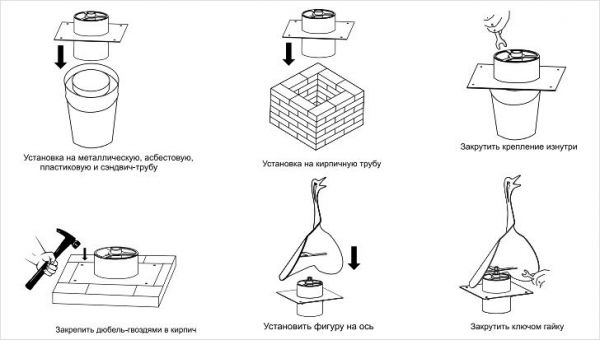

Installation of a weather vane
Simple vaulted umbrellas with a minimum number of folds and cuts have a less complex design. The fixing of such a smoke umbrella on an oval chimney pipe is carried out due to the presence of racks bent from sheet steel of sufficient thickness or made using standard metal corners.
Regardless of the manufacturing method, the racks can be fixed in several ways:
- on metal and asbestos chimneys, you can use a metal clamp or make a regular wire frame yourself;
- the wire for the frame base should be as strong and reliable as possible;
- mounting holes are drilled in the racks;
- The lead-out parts of the twisted wire frame are passed through the fastening holes on the posts and screwed until the smoke umbrella is fully fixed.
On brick chimneys, even standard galvanized nails of sufficient length, implanted directly into the masonry, can be used to fix the "umbrella". However, as practice shows, it is best to drill holes in the brickwork through the pre-drilled holes in the umbrella postsand then fix the hood on the chimney with steel pins or galvanized screws.
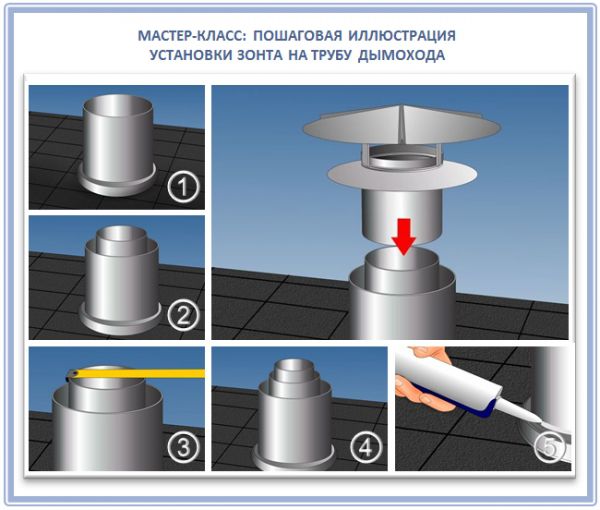

Mounting the umbrella
In this case, if necessary, it will be possible to quickly and with minimal expenditure of effort independently dismantle the umbrella for cleaning or replacement.
CAUTION!
It should be remembered that when using a gas system as an autonomous heating, it is strongly not recommended to install an umbrella on a chimney.
DIY installation
To carry out the correct installation of the hood is within the power of the artisan owner. To install with your own hands in the back wall of the wall umbrella, you need to drill 2-3 identical holes, with anchors through the enlarged models of washers, first pull it in, and then install it on the wall as close as possible to the ventilation duct on the roof. The main thing is that the surface of the wall is flat and solid.
A rectangular umbrella is attached to the ceiling using a collet and pins, for which 4 identical holes must be drilled along the edges of the umbrella in the upper horizontal plane. It should be borne in mind that with a ceiling height of more than 4 m, this technology cannot be applied.
Used for the installation of hanging hoods, cables and chains. In this case, the height of the ceiling does not matter. First, 4 brackets are welded to the upper plane of the hood. Then, using a carabiner, the chain (or cable) is fixed. Its other end is connected to the ceiling. All fasteners must be secure. The only "minus" of such overhanging unsecured structures is the difficulty of tying them with air ducts.
How to make a chimney umbrella with your own hands
Before manufacturing, the diameter of the chimney is necessarily measured, and the step-by-step manufacturing technology for such a structure is as follows:
- cut a tin strip 70-80mm wide and length depending on the diameter of the chimney with the addition of a small margin for fastening;
- on a caliper, draw the strips with an indentation of 10 mm from the edge of the tin strip;
- hammer through the rails in accordance with the marked stripes, which will allow you to easily and evenly fold the workpiece;
- make four parts according to the strip marks, tap, make a right angle, wrap and finally punch with a hammer;
- prepare a cardboard round patternthe diameter of which exceeds the size of the chimney by 150 mm;
- cut out a tin circle for the umbrella in accordance with the prepared template and cut out an angle that allows assembly in the shape of a cone.
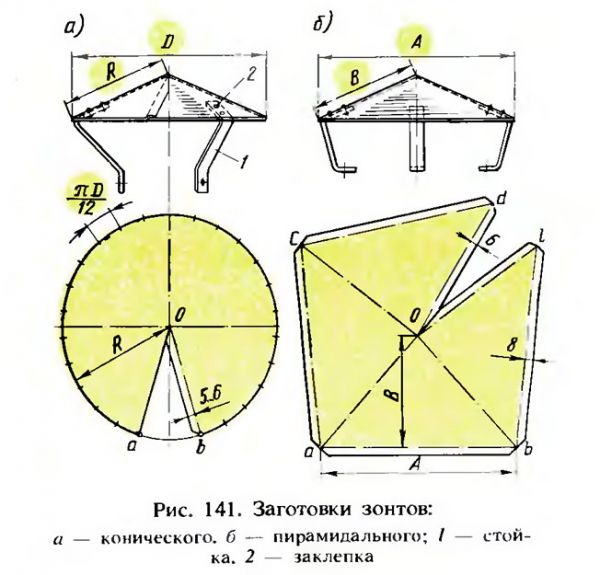

DIY umbrellas
The finished umbrella must be riveted in a couple of places, after which it is required to attach three reinforcement strips or so-called racks to the structure.
IMPORTANT!
The easiest way to improve the appearance of the finished structure is to beautifully design the edges.... For this purpose, you can make metal cuts along the edges and slightly bend the resulting "petals" or bend the wavy cut edges.
Making and installing an umbrella
The simplest fungus for ventilation can be made by hand. To do this, you need a galvanized or stainless steel sheet with a thickness of 0.3-0.5 mm.
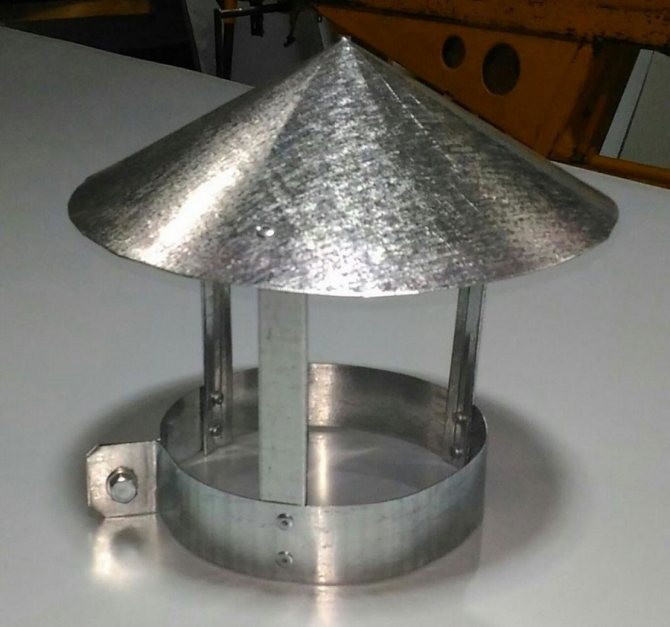

Do not use too thick metal in the manufacture of the umbrella, as this will complicate the work. When choosing the material from which the fungus will be made, it is better to give preference to stainless metals or those with a coating that protects against corrosion
From the tool you will need:
- Scissors for metal or grinder;
- A hammer;
- Riveter with rivets;
- Drill or screwdriver with a drill;
- HB gloves.
An M8 bolt with nut is required to secure the clamp to the pipe. Instead of rivets during assembly, you can use self-tapping screws for metal, while they will have to be screwed into the clamp from the inside so that in the future they do not interfere with installation on the ventilation pipe.
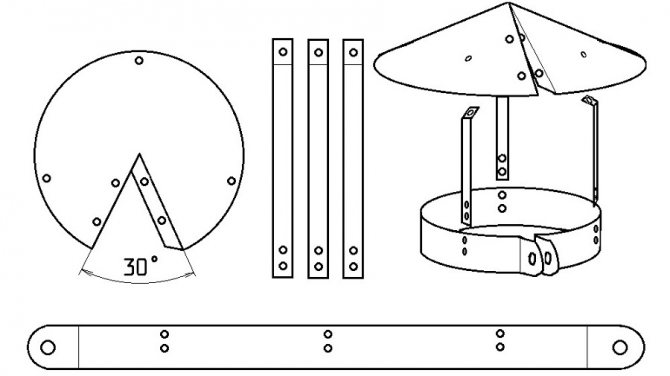

Sketches can be taken as a basis for making an umbrella. The specific dimensions of the parts will depend on the diameter of the ventilation pipe. The length of the clamp from bend to bend is equal to the circumference of the pipe reduced by 5 mm. The diameter of the cap is equal to two diameters of the pipe
The manufacturing process is not complicated and does not require special skills:
- First, on a sheet of metal with a permanent marker, we mark future parts: a clamp for fastening to a pipe, three legs for fastening and an umbrella-cap. We cut them out with scissors for metal;
- In the clamp along the edges we drill holes for the tie bolt. We give the clamp the shape of a circle, and bend the ears with holes at an angle of 90 degrees, insert the bolt, fix it with a nut;
- Drill three pairs of rivet-sized holes in the clamp for attaching the feet at 120-degree intervals. In each foot for attaching an umbrella, we drill three holes: two on one side for connection with a clamp and one on the other for connection with an umbrella. We fasten the legs on the clamp with rivets;
- We roll up the umbrella-cap in the shape of a cone. In the place of the overlap, we drill several holes and connect the edges of the umbrella with rivets. With an interval of 120 degrees, we drill three holes along the edge of the umbrella and connect with rivets with the legs from the clamp. The umbrella is ready.
You can make such an umbrella for ventilation pipes from any material and any size. To install the umbrella, it is necessary to put it on the pipe head with a clamp and tighten it with a tightening screw and nut.
To give the umbrella hood additional aesthetics and protection against corrosion, it can be painted in the color of the ventilation pipe or roof. Any paint for metal for outdoor use is suitable for this, since the ventilation umbrella is not exposed to high temperatures.
If you decide to install a factory-made umbrella, then you need to choose a product that is suitable for your ventilation pipe in terms of size and method of connection.
Exhaust hoods from the manufacturer
When designing and installing a ventilation system, it is important to comply with the requirements of technical regulations, GOSTs and SNiPs. Stainless steel exhaust hoods, one of the most important elements of the ventilation system of any kitchen, are very demanding. The connecting dimensions of the exhaust hoods with a grease trap must strictly correspond to the fitting dimensions of pipes and fasteners.
Local ventilation extractors that meet the most stringent requirements for ventilation systems are available or can be produced by EuroVentGroup at quite reasonable prices.
Table of characteristics of exhaust and supply and exhaust hoods
An example of making an umbrella on a pipe
An umbrella attached to the top of the pipe will perform the function of air extraction.The accumulated air masses from the release of harmful gases, vapors, dust, heat have harmful consequences when a person inhales oxygen.
The installed umbrella on the pipe creates a huge draft at the slightest movement of the wind, and if you open the doors, the window, the opening will be supply and exhaust ventilation. The incoming air will dry out the walls in a short time during repair, remove moisture from the room in a hard-to-reach place, grass, workpieces that require drying during use.
Also, the umbrella helps to get rid of atmospheric precipitation in the form of heavy rain and snow. A garage, a small warehouse, a cellar have vulnerable spots where rain falling down the pipe will create unpleasant conditions. Bringing moisture, dampness from which mold appears, creating an unpleasant odor. Water can damage items accidentally left in the wrong place.
Making repairs in your yard with your own hands without specialists, you want to save money or learn.
Consider a drawing for making a circular umbrella on a pipe with your own hands. This type of pipe is also called a chimney.
For the umbrella, we need a material made of galvanized iron or black sheet. The thickness of the iron should not exceed 0.5-0.7 mm. It will be difficult for you to make more than 1 mm, since we will make the umbrella by hand.
For a sample, take cardboard, if not, then paper, it is better to spoil paper than metal
Making the upper part of the umbrella (cone)
We make an umbrella with a circular cross-section with a diameter of 150 mm, respectively, and the outer diameter of the pipe should be 150 mm. Cutting turns out like this. With a metal ruler, apply to the iron sheet, mark a segment of 150 mm (15 cm). We put the caliper with sponges to the first mark of the segment where 0 is located, and the second mark is 150. Holding the caliper
draw a circle. The diameter of our circle is 300 mm.
xn —— dlckc9bidcgrpu.xn - p1ai
